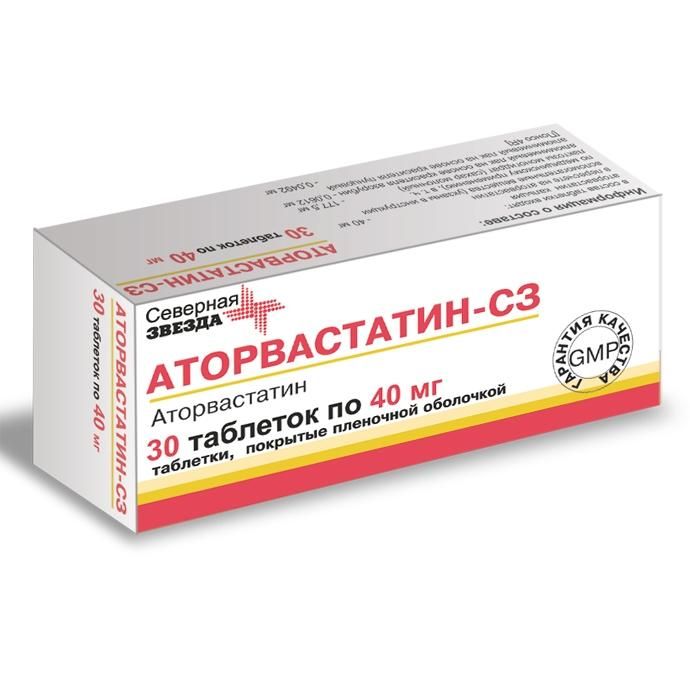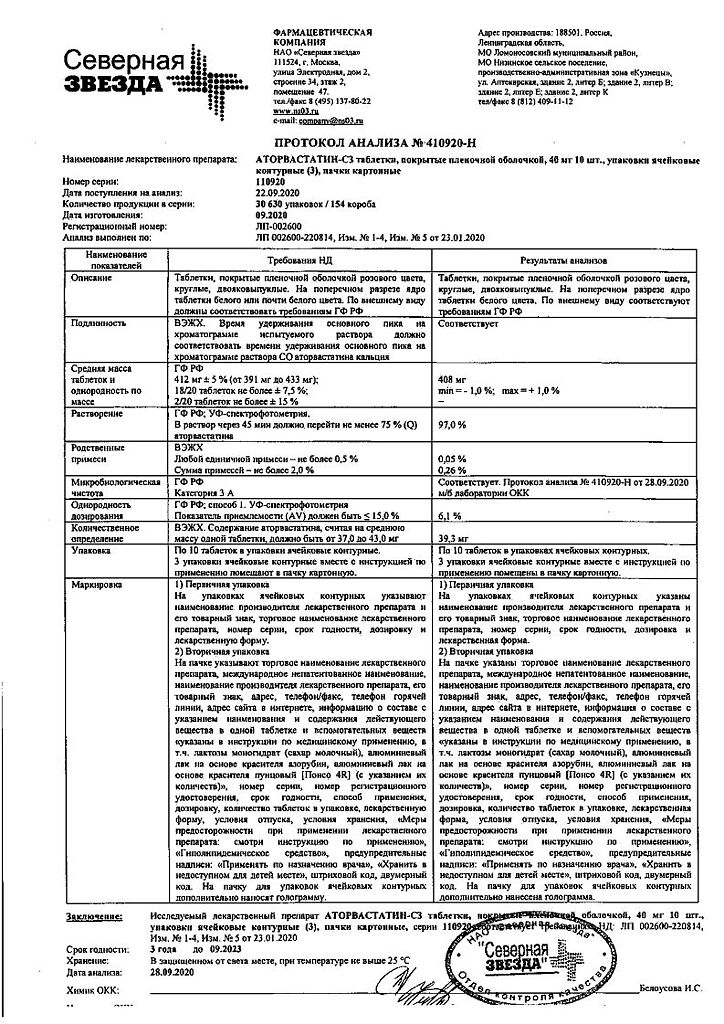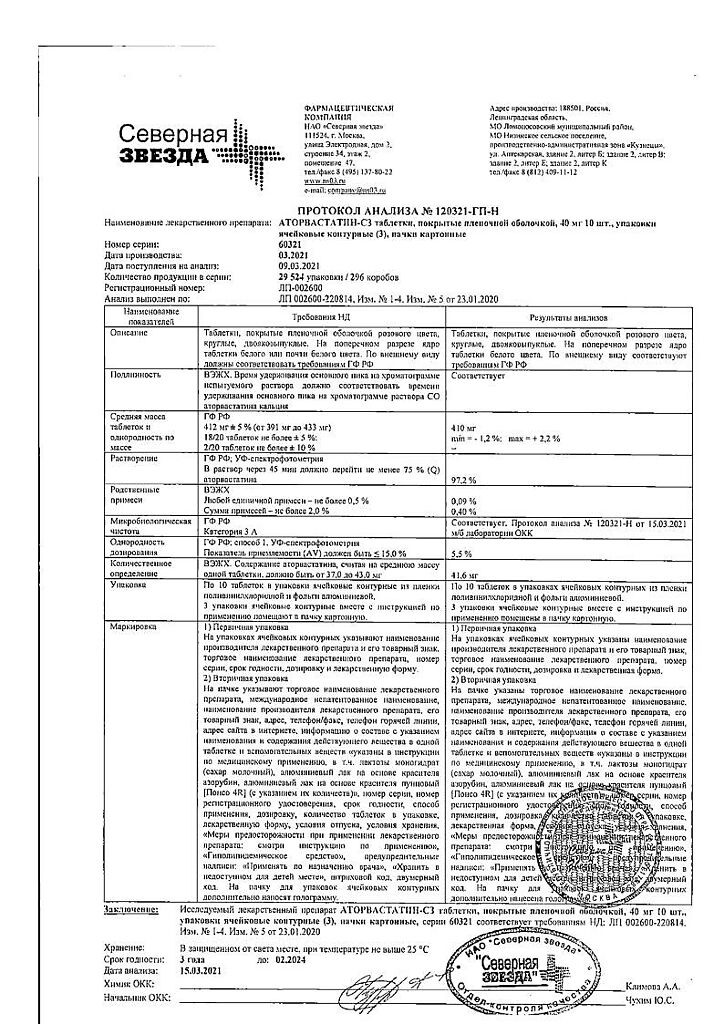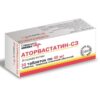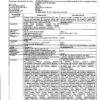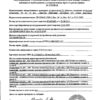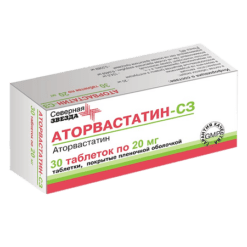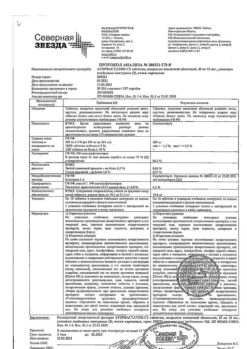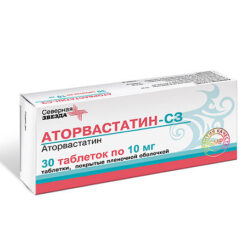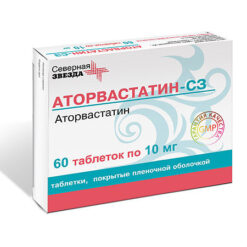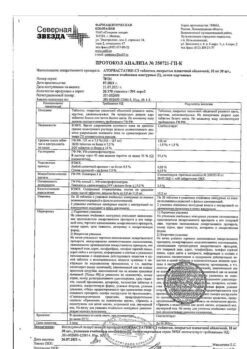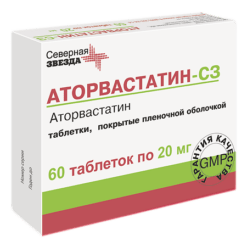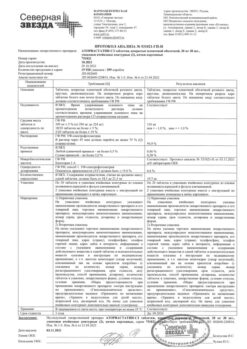No products in the cart.
Atorvastatin-SZ, 40 mg 30 pcs
€7.68 €6.72
Description
Atorvastatin is a selective competitive inhibitor of HMG-CoA reductase, a key enzyme converting 3-hydroxy-3-methylglutaryl-CoA to mevalonate, a precursor of steroids, including cholesterol; a synthetic hypolipidemic drug.
. In patients with homozygous and heterozygous familial hypercholesterolemia, nonfamilial forms of hypercholesterolemia and mixed dyslipidemia, atorvastatin reduces plasma cholesterol (CH) low density lipoprotein cholesterol (LDL-C) and apolipoprotein B (apo-B), as well as very low density lipoprotein cholesterol (VLDL-C) and triglycerides (TG), causes unstable increase of high density lipoprotein cholesterol (HDL-C) concentration.
Atorvastatin reduces plasma concentrations of cholesterol and lipoproteins by inhibiting HMG-CoA reductase and cholesterol synthesis in the liver and increasing the number of “hepatic” LDL receptors on the cell surface, which leads to increased capture and catabolism of LDL-C.
Atorvastatin decreases formation of LDL-C and the number of LDL particles, causes a pronounced and sustained increase in LDL receptor activity in combination with favorable qualitative changes of LDL particles and decreases LDL-C concentration in patients with homozygous hereditary familial hypercholesterolemia resistant to therapy with other hypolipidemic agents.
Atorvastatin at doses of 10 mg to 80 mg reduces cholesterol concentration by 30% to 46%, LDL-C by 41% to 61%, apolipoprotein-b by 34% to 50% and TG by 14% to 33%. The results of therapy are similar in patients with heterozygous familial hypercholesterolemia, nonfamilial forms of hypercholesterolemia and mixed hyperlipidemia, including patients with type 2 diabetes.
In patients with isolated hypertriglyceridemia atorvastatin reduces cholesterol, LDL-C, LDL-C, apo-B and TG concentrations and increases HDL-C concentration. In patients with dysbetalipoproteinemia, atorvastatin reduces the concentration of intermediate-density lipoprotein cholesterol.
In patients with hyperlipoproteinemia of type IIa and IIb according to Fredrickson classification mean increase of HDL-C concentration during treatment with atorvastatin (10-80 mg) in comparison with baseline is 5.1 % – 8.7 % and it is not dose dependent. There is a significant dose-dependent decrease in the values of the ratios: total cholesterol/CHD-LDP and CHD-LDL/CHD-LDP by 29 % – 44 % and 37 % – 55 %, respectively.
The antisclerotic effect of atorvastatin is a consequence of its effect on the vascular wall and blood components. Atorvastatin inhibits the synthesis of isoprenoids, which are growth factors of the cells of the inner membrane of blood vessels. Under the action of atorvastatin endothelium-dependent dilation of blood vessels improves, concentration of HDL-C, apolipoprotein B, TG decreases, concentration of HDL-C and apolipoprotein A cholesterol increases.
Atorvastatin reduces plasma viscosity and the activity of some clotting factors and platelet aggregation. Due to this it improves hemodynamics and normalizes the state of the clotting system. HMG-CoA reductase inhibitors also affect the metabolism of macrophages, block their activation and prevent the rupture of atherosclerotic plaque.
Atorvastatin-CZ at a dose of 80 mg significantly reduces the risk of coronary complications and mortality rate by 16% after a 16-week course, and the risk of readmission for angina with signs of myocardial ischemia by 26%. In patients with different baseline concentrations of LDL-C, Atorvastatin-CS causes reduction of risk of ischemic complications and mortality (in patients with myocardial infarction without Q-wave and unstable angina, as well as in men and women, and in patients aged younger and older than 65 years).
The decrease in plasma concentration of LDL-C correlates better with the drug dose than with its plasma concentration. The dose is adjusted taking into account the therapeutic effect (see section “Dosage and administration”).
Therapeutic effect is achieved 2 weeks after the start of therapy, reaches a maximum after 4 weeks and lasts for the duration of therapy.
Pharmacokinetics:
Intake
Atorvastatin is quickly absorbed after oral administration: time of reaching its maximum concentration (TSmax) in plasma is 1-2 hours. In women maximal concentration (CMax) of atorvastatin is 20% higher and area under curve “concentration-time” (AUC) is 10% lower than in men. The degree of absorption and plasma concentration increase in proportion to the dose.
The absolute bioavailability is about 14 % and systemic bioavailability of HMG-CoA reductase inhibitory activity is about 30 %. Low systemic bioavailability is due to presystemic metabolism in the mucosa of the gastrointestinal tract and/or during “primary passage” through the liver. Food intake reduces the rate and degree of drug absorption (by 25% and 9%, respectively), as evidenced by the results of Cmax and AUC determination, but decrease of LDL-C is similar to that of atorvastatin on an empty stomach. Despite the fact that after Atorvastatin administration in the evening its concentration in plasma is lower (Cmax and AUC, approximately by 30%) than after administration in the morning, decrease of LDL-C concentration does not depend on the time of day, when the drug is taken.
Distribution
The mean volume of distribution of atorvastatin is about 381 liters. The binding to plasma proteins is at least 98%. The ratio of content in erythrocytes/plasma is about 0.25, i.e. atorvastatin poorly penetrates into erythrocytes.
Metabolism
Atorvastatin is largely metabolized with the formation of ortho- and parahydroxylated derivatives and various β-oxidation products. In vivo ortho- and parahydroxylated metabolites have an inhibitory effect on HMG-CoA reductase comparable with that of atorvastatin. Approximately 70% of the decrease of HMG-CoA reductase activity is due to the action of active circulating metabolites. The results of in vitro studies suggest that hepatic CYPCA4 isoenzyme plays an important role in atorvastatin metabolism. This fact is supported by increased plasma concentrations of the drug with concomitant administration of erythromycin, which is an inhibitor of this isoenzyme. Studies have also shown that atorvastatin is a weak inhibitor of CYP3A4 isoenzyme. Atorvastatin has no clinically significant effect on plasma concentrations of terfenadine, which is metabolized primarily by CYPCA4 isoenzyme, therefore its significant effect on pharmacokinetics of other substrates of CYPCA4 isoenzyme is unlikely (see section “Interaction with other medicinal products”).
Atorvastatin and its metabolites are excreted mainly with bile after hepatic and/or extrahepatic metabolism (atorvastatin does not undergo marked hepatic recirculation). The half-life (T1/2) of atorvastatin is about 14 h, while its inhibitory effect against HMG-CoA reductase is about 70% determined by the activity of circulating metabolites and persists for about 20 – 30 hours due to their presence. After oral administration, less than 2% of the administered dose of the drug is detected in the urine.
Special groups of patients
Elderly patients
The plasma concentrations of atorvastatin in patients over 65 years old are higher (Cmax by about 40%, AUC by about 30%) than in adult patients of younger age. No differences in efficacy and safety of the drug, or achievement of the goals of hypolipidemic therapy in elderly patients compared to the general population have been found.
Children
There have been no studies of pharmacokinetics of the drug in children.
Inadequate renal function
Induced renal function has no effect on plasma concentrations of atorvastatin or its effect on lipid metabolism parameters; therefore, no dose change is required in patients with impaired renal function.
Atorvastatin is not excreted during hemodialysis due to intense binding to plasma proteins.
There have been no studies of atorvastatin use in patients with end-stage renal failure.
Liver function insufficiency
The drug concentration is significantly increased (Cmax approximately 16-fold, AUC approximately 11-fold) in patients with alcoholic cirrhosis (stage B on the Child-Pugh scale) (see section “Contraindications”).
Indications
Indications
– in combination with a diet to reduce elevated levels of total cholesterol, LDL cholesterol, apolipoprotein B and TG and increase the level of HDL cholesterol in patients with primary hypercholesterolemia, heterozygous familial and non-familial hypercholesterolemia and combined (mixed) hyperlipidemia (types IIa and IIb according to Fredrickson);
– in combination with diet for the treatment of patients with elevated serum TG levels (Fredrickson type IV) and patients with dysbetalipoproteinemia (Fredrickson type III) in whom diet therapy does not provide an adequate effect;
– to reduce the levels of total cholesterol and LDL cholesterol in patients with homozygous familial hypercholesterolemia, when diet therapy and other non-pharmacological treatment methods are not effective enough.
Pharmacological effect
Pharmacological effect
Atorvastatin is a selective competitive inhibitor of HMG-CoA reductase, a key enzyme that converts 3-hydroxy-3-methylglutaryl-CoA into mevalonate, a precursor of steroids, including cholesterol; synthetic lipid-lowering agent.
In patients with homozygous and heterozygous familial hypercholesterolemia, non-familial forms of hypercholesterolemia and mixed dyslipidemia, atorvastatin reduces the plasma concentrations of cholesterol (C), low-density lipoprotein cholesterol (LDL-C) and apolipoprotein B (apo-B), as well as very low-density lipoprotein cholesterol (VLDL-C) and triglycerides (TG), causes an unstable increase in the concentration of high-density lipoprotein cholesterol (HDL-C).
Atorvastatin reduces the concentration of cholesterol and lipoproteins in the blood plasma by inhibiting HMG-CoA reductase and cholesterol synthesis in the liver and increasing the number of “liver” LDL receptors on the cell surface, which leads to increased uptake and catabolism of LDL-C.
Atorvastatin reduces the formation of LDL-C and the number of LDL particles, causes a pronounced and persistent increase in the activity of LDL receptors in combination with favorable qualitative changes in LDL particles, and also reduces the concentration of LDL-C in patients with homozygous hereditary familial hypercholesterolemia, resistant to therapy with other lipid-lowering drugs.
Atorvastatin in doses from 10 mg to 80 mg reduces the concentration of cholesterol by 30% – 46%, LDL-C by 41% – 61%, apolipoprotein-B by 34% – 50% and TG by 14% – 33%. The results of therapy are similar in patients with heterozygous familial hypercholesterolemia, non-familial forms of hypercholesterolemia and mixed hyperlipidemia, including patients with type 2 diabetes mellitus.
In patients with isolated hypertriglyceridemia, atorvastatin reduces the concentration of cholesterol, LDL-C, VLDL-C, apo-B and TG and increases the concentration of HDL-C. In patients with dysbetalipoproteinemia, atorvastatin reduces the concentration of intermediate-density lipoprotein cholesterol.
In patients with hyperlipoproteinemia types IIa and IIb according to the Fredrickson classification, the average increase in HDL-C concentration during treatment with atorvastatin (10-80 mg) compared to baseline is 5.1% – 8.7% and is independent of dose. There is a significant dose-dependent decrease in the ratios: total cholesterol/HDL-C and LDL-C/HDL-C by 29% – 44% and 37% – 55%, respectively.
The antisclerotic effect of atorvastatin is a consequence of its effect on the walls of blood vessels and blood components. Atorvastatin inhibits the synthesis of isoprenoids, which are growth factors for the cells of the inner lining of blood vessels. Under the influence of atorvastatin, endothelium-dependent dilation of blood vessels improves, the concentration of LDL-C, apolipoprotein B, and TG decreases, and the concentration of HDL-C and apolipoprotein A increases.
Atorvastatin reduces the viscosity of blood plasma and the activity of some coagulation factors and platelet aggregation. Thanks to this, it improves hemodynamics and normalizes the state of the coagulation system. HMG-CoA reductase inhibitors also affect the metabolism of macrophages, block their activation and prevent rupture of atherosclerotic plaque.
Atorvastatin-SZ at a dose of 80 mg significantly reduces the risk of ischemic complications and mortality by 16% after a 16-week course, and the risk of re-hospitalization for angina pectoris accompanied by signs of myocardial ischemia by 26%.
In patients with different baseline LDL-C concentrations, Atorvastatin-SZ causes a reduction in the risk of ischemic complications and mortality (in patients with non-Q wave myocardial infarction and unstable angina, as well as in men and women, and in patients younger and older than 65 years).
The decrease in plasma LDL-C concentration correlates better with the dose of the drug than with its plasma concentration. The dose is selected taking into account the therapeutic effect (see section “Method of administration and dosage”).
The therapeutic effect is achieved 2 weeks after the start of therapy, reaches a maximum after 4 weeks and persists throughout the entire period of therapy.
Pharmacokinetics:
Suction
Atorvastatin is rapidly absorbed after oral administration: the time to reach its maximum concentration (TCmax) in the blood plasma is 1-2 hours. In women, the maximum concentration (Cmax) of atorvastatin is 20% higher, and the area under the concentration-time curve (AUC) is 10% lower than in men. The degree of absorption and plasma concentration increase in proportion to the dose.
Absolute bioavailability is about 14%, and systemic bioavailability of inhibitory activity against HMG-CoA reductase is about 30%. Low systemic bioavailability is due to first-pass metabolism in the mucous membrane of the gastrointestinal tract and/or during “first pass” through the liver. Eating reduces the rate and extent of drug absorption (by 25% and 9%, respectively), as evidenced by the results of determining Cmax and AUC, but the reduction in LDL-C is similar to that when taking atorvastatin on an empty stomach.
Despite the fact that after taking atorvastatin in the evening, its plasma concentration is lower (Cmax and AUC by approximately 30%) than after taking it in the morning, the decrease in LDL-C concentration does not depend on the time of day at which the drug is taken.
Distribution
The mean volume of distribution of atorvastatin is approximately 381 L. Communication with blood plasma proteins is not less than 98%. The erythrocyte/blood plasma ratio is about 0.25, i.e. atorvastatin penetrates erythrocytes poorly.
Metabolism
Atorvastatin is extensively metabolized to form ortho- and parahydroxylated derivatives and various β-oxidation products. In vitro, ortho- and parahydroxylated metabolites have an inhibitory effect on HMG-CoA reductase comparable to that of atorvastatin. Approximately 70% of the decrease in HMG-CoA reductase activity occurs due to the action of active circulating metabolites. The results of in vitro studies suggest that the liver isoenzyme CYP3A4 plays an important role in the metabolism of atorvastatin.
This fact is supported by an increase in the concentration of the drug in the blood plasma while taking erythromycin, which is an inhibitor of this isoenzyme. In vitro studies also showed that atorvastatin is a weak inhibitor of the CYP3A4 isoenzyme. Atorvastatin does not have a clinically significant effect on the plasma concentration of terfenadine, which is metabolized mainly by the CYP3A4 isoenzyme, so its significant effect on the pharmacokinetics of other CYP3A4 isoenzyme substrates is unlikely (see section “Interaction with other drugs”).
Removal
Atorvastatin and its metabolites are excreted mainly in bile after hepatic and/or extrahepatic metabolism (atorvastatin does not undergo significant enterohepatic recirculation). The half-life (T1/2) of atorvastatin is about 14 hours, while the inhibitory effect of the drug on HMG-CoA reductase is approximately 70% determined by the activity of circulating metabolites and persists for about 20-30 hours due to their presence. After oral administration, less than 2% of the administered dose of the drug is found in the urine.
Special patient groups
Elderly patients
Plasma concentrations of atorvastatin in patients over 65 years of age are higher (Cmax approximately 40%, AUC approximately 30%) than in younger adult patients. There were no differences in the efficacy and safety of the drug, or the achievement of lipid-lowering therapy goals in elderly patients compared with the general population.
Children
Pharmacokinetic studies of the drug have not been conducted in children.
Kidney failure
Impaired renal function does not affect the plasma concentration of atorvastatin or its effect on lipid metabolism, and therefore no dose adjustment is required in patients with impaired renal function.
Atorvastatin is not excreted during hemodialysis due to intense binding to plasma proteins.
There have been no studies of atorvastatin in patients with end-stage renal disease.
Liver failure
The concentration of the drug is significantly increased (Cmax approximately 16 times, AUC approximately 11 times) in patients with alcoholic cirrhosis (stage B on the Child-Pugh scale) (see section “Contraindications”).
Special instructions
Special instructions
Before starting therapy with Atorvastatin, an attempt should be made to control hypercholesterolemia through adequate diet therapy, increased physical activity, weight loss in obese patients, and treatment of other conditions. Patients must follow a cholesterol-lowering diet during the entire treatment period.
The use of HMG-CoA reductase inhibitors to reduce blood lipid levels can lead to changes in biochemical parameters reflecting liver function. Liver function should be monitored before starting therapy, 6 weeks, 12 weeks after starting Atorvastatin and after each dose increase, and periodically, for example, every 6 months. An increase in the activity of liver enzymes in the blood serum may be observed during therapy with Atorvastatin.
In such cases, the patient’s condition should be monitored until the activity of liver enzymes normalizes. If ALT or AST values are more than 3 times the ULN, it is recommended to reduce the dose of Atorvastatin or discontinue treatment. Active liver disease or persistent increases in aminotransferase activity of unknown origin are contraindications to the use of Atorvastatin.
Treatment with Atorvastatin may cause myopathy. Patients with widespread myalgia, muscle soreness or weakness, and/or a marked increase in CPK activity are likely to develop myopathy (muscle pain and weakness in combination with an increase in CPK activity by more than 10 times the ULN). Atorvastatin therapy should be discontinued in the event of a marked increase in CPK activity or in the presence of confirmed or suspected myopathy.
The risk of myopathy during treatment with other drugs in this class was increased with concomitant use of cyclosporine, fibrates, erythromycin, niacin, or azole antifungals. Many of these drugs inhibit CYP3A4-mediated metabolism and/or drug transport.
Atorvastatin is biotransformed by CYP3A4. When prescribing Atorvastatin in combination with fibrates, erythromycin, immunosuppressants, azole antifungals or nicotinic acid in lipid-lowering doses, the expected benefits and risks of treatment should be carefully weighed and patients should be regularly monitored for muscle pain or weakness, especially during the first months of treatment and during periods of increasing the dose of any drug. In such situations, periodic determination of CPK activity can be recommended, although such monitoring does not prevent the development of severe myopathy.
When using Atorvastatin, as well as other drugs of this class, cases of rhabdomyolysis with acute renal failure caused by myoglobinuria have been described. Atorvastatin therapy should be temporarily discontinued or completely discontinued if signs of possible myopathy appear or if there is a risk factor for the development of renal failure due to rhabdomyolysis (for example, severe acute infection, hypotension, major surgery, trauma, severe metabolic, endocrine and electrolyte disturbances, and uncontrolled seizures).
Patients should be warned to seek immediate medical attention if they experience unexplained muscle pain or weakness, especially if they experience malaise or fever.
Impact on the ability to drive vehicles and operate machinery
When driving vehicles or operating machinery, patients should be careful because When using Atorvastatin, there is a risk of dizziness.
For impaired renal function
In patients with renal failure and kidney disease, the concentration of atorvastatin in the blood plasma does not change, the degree of reduction in LDL cholesterol is maintained, so a change in the dose of the drug is not required.
For liver dysfunction
The drug is contraindicated in active liver diseases; increased activity of liver enzymes of unknown origin (more than 3 times compared to ULN); with liver failure (classes A and B on the Child-Pugh scale).
In case of liver failure, the dose of the drug should be reduced.
Use in childhood
Contraindicated in people under 18 years of age (efficacy and safety have not been established).
Active ingredient
Active ingredient
Atorvastatin
Composition
Composition
1 film-coated tablet contains:
active ingredient: atorvastatin calcium – 43.4 mg in terms of atorvastatin – 40 mg
excipients (core): lactose monohydrate (milk sugar) – 174.1 mg; calcium carbonate – 77.0 mg; povidone K 30 (medium molecular weight polyvinylpyrrolidone) – 16.0 mg; croscarmellose sodium (primellose) – 14.0 mg; sodium stearyl fumarate – 4.0 mg; colloidal silicon dioxide (Aerosil) – 1.5 mg; microcrystalline cellulose 102 – 70.0 mg;
shell composition:
hypromellose – 6.0 mg; polysorbate-80 (Tween-80) – 2.4 mg; talc – 2.4 mg; titanium dioxide E 171 – 1.104 mg; aluminum varnish based on azorubine dye – 0.096 mg.
Contraindications
Contraindications
– active liver diseases;
– increased activity of liver enzymes of unknown origin (more than 3 times compared to ULN);
– liver failure (classes A and B on the Child-Pugh scale);
– pregnancy;
– lactation period;
– age under 18 years (efficacy and safety have not been established);
– hypersensitivity to the components of the drug.
The drug should be used with caution in patients with chronic alcoholism, a history of liver disease, severe electrolyte imbalance, endocrine and metabolic disorders, arterial hypotension, severe acute infections (sepsis), uncontrolled epilepsy, extensive surgical interventions, trauma, and skeletal muscle diseases.
Side Effects
Side Effects
From the nervous system: > 1% – insomnia, dizziness; <1% - headache, asthenia, malaise, drowsiness, nightmares, paresthesia, peripheral neuropathy, amnesia, emotional lability, ataxia, facial paralysis, hyperkinesis, migraine, depression, hypoesthesia, loss of consciousness.
From the senses: <1% - amblyopia, tinnitus, dry conjunctiva, impaired accommodation, hemorrhage in the retina, deafness, glaucoma, parosmia, loss of taste, taste perversion.
From the cardiovascular system: > 1% – chest pain; <1% - palpitations, symptoms of vasodilation, orthostatic hypotension, increased blood pressure, phlebitis, arrhythmia, angina pectoris.
From the hematopoietic system: <1% - anemia, lymphadenopathy, thrombocytopenia.
From the respiratory system: > 1% – bronchitis, rhinitis; <1% - pneumonia, dyspnea, exacerbation of bronchial asthma, nosebleeds.
From the digestive system: > 1% – nausea; <1% - heartburn, constipation or diarrhea, flatulence, gastralgia, abdominal pain, decreased or increased appetite, dry mouth, belching, dysphagia, vomiting, stomatitis, esophagitis, glossitis, erosive and ulcerative lesions of the oral mucosa, gastroenteritis, hepatitis, biliary colic, cheilitis, duodenal ulcer, pancreatitis, cholestatic jaundice, liver dysfunction, rectal bleeding, melena, bleeding gums, tenesmus.
From the musculoskeletal system: > 1% – arthritis; <1% - leg muscle cramps, bursitis, tenosynovitis, myositis, myopathy, arthralgia, myalgia, rhabdomyolysis, torticollis, muscle hypertonicity, joint contractures, joint swelling, tendinopathy (in some cases with tendon rupture).
From the genitourinary system: > 1% – urogenital infections, peripheral edema; <1% - dysuria (including pollakiuria, nocturia, urinary incontinence or urinary retention, urinary urgency), leukocyturia, nephritis, hematuria, vaginal bleeding, nephrourolithiasis, metrorrhagia, epididymitis, decreased libido, impotence, ejaculation disorder.
Dermatological reactions: > 1% – alopecia, xeroderma, photosensitivity, increased sweating, eczema, seborrhea, ecchymosis, petechiae.
From the endocrine system: <1% - gynecomastia, mastodynia.
From the metabolic side: <1% - increase in body weight, exacerbation of gout.
Allergic reactions: <1% - itching, skin rash, contact dermatitis, rarely - urticaria, angioedema, facial swelling, anaphylaxis, erythema multiforme (including Stevens-Johnson syndrome), toxic epidermal necrolysis (Lyell's syndrome).
Laboratory indicators: <1% - hyperglycemia, hypoglycemia, increased serum CPK, albuminuria.
Interaction
Interaction
When atorvastatin is used simultaneously with cyclosporine, HIV protease inhibitors (indinavir, ritonavir), antibiotics (erythromycin, clarithromycin, quinupristin/dalfopristin), azole antifungals (fluconazole, itraconazole, ketoconazole), nefazodone, fibric acid derivatives, nicotinic acid or diltiazem concentration atorvastatin plasma levels increase, which increases the risk of developing myopathy with rhabdomyolysis and acute renal failure.
With simultaneous oral administration of Atorvastatin and a suspension containing magnesium hydroxide and aluminum hydroxide, the concentration of atorvastatin in the blood plasma decreased by approximately 35%, but the degree of reduction in LDL-C levels did not change.
With simultaneous use, Atorvastatin does not affect the pharmacokinetics of antipyrine (phenazone), therefore, interaction with other drugs metabolized by the same isoenzymes of the cytochrome P450 system is not expected.
With simultaneous use of colestipol, the concentration of atorvastatin in the blood plasma is reduced by approximately 25%. However, the lipid-lowering effect of the combination of Atorvastatin and colestipol was superior to that of each drug alone.
With repeated administration of digoxin and Atorvastatin at a dose of 10 mg, the Css of digoxin in the blood plasma did not change. However, when digoxin was used in combination with Atorvastatin at a dose of 80 mg/day, the concentration of digoxin increased by approximately 20%. When using this combination, patients should be monitored.
With the simultaneous use of Atorvastatin and erythromycin (500 mg 4 times / day) or clarithromycin (500 mg 2 times / day), which inhibit the CYP3A4 isoenzyme, an increase in the concentration of atorvastatin in the blood plasma was observed.
With simultaneous use of Atorvastatin (10 mg 1 time / day) and azithromycin (500 mg 1 time / day), the concentration of atorvastatin in the blood plasma did not change.
Atorvastatin did not have a clinically significant effect on plasma concentrations of terfenadine, which is metabolized primarily by CYP3A4; in this regard, it seems unlikely that Atorvastatin can significantly affect the pharmacokinetic parameters of other substrates of the CYP3A4 isoenzyme.
When atorvastatin was coadministered with an oral contraceptive containing norethindrone and ethinyl estradiol, significant increases in the AUC of norethindrone and ethinyl estradiol by approximately 30% and 20%, respectively, were observed. This effect should be taken into account when choosing an oral contraceptive for a woman receiving Atorvastatin.
Concomitant use with drugs that reduce the concentration of endogenous steroid hormones (including cimetidine, ketoconazole, spironolactone) increases the risk of a decrease in endogenous steroid hormones (caution is required with these combinations).
When studying the interaction of Atorvastatin with warfarin and cimetidine, no signs of clinically significant interaction were found.
With simultaneous use of Atorvastatin at a dose of 80 mg and amlodipine at a dose of 10 mg, the pharmacokinetics of atorvastatin at steady state did not change.
There were no clinically significant adverse interactions between Atorvastatin and antihypertensive drugs.
The simultaneous use of Atorvastatin with protease inhibitors known as CYP3A4 inhibitors (grapefruit juice) was accompanied by an increase in the concentration of atorvastatin in the blood plasma, and therefore the use of this juice should be avoided.
The simultaneous use of Atorvastatin with inducers of the CYP3A4 isoenzyme (efavirenz, rifampicin) leads to a decrease in the concentration of atorvastatin in the blood plasma.
No pharmaceutical incompatibilities are known.
Overdose
Overdose
Treatment: there is no specific antidote; symptomatic therapy is carried out. Hemodialysis is ineffective.
Storage conditions
Storage conditions
In a dry place, protected from light, at a temperature not exceeding 25 °C.
Shelf life
Shelf life
3 years
Manufacturer
Manufacturer
North Star NAO, Russia
Additional information
| Manufacturer | North Star NAO, Russia |
|---|---|
| Medication form | pills |
| Brand | North Star NAO |
Other forms…
Related products
Buy Atorvastatin-SZ, 40 mg 30 pcs with delivery to USA, UK, Europe and over 120 other countries.

